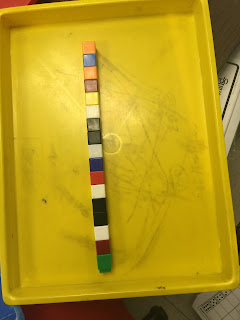It's the same every year. I think my sanity is in jeopardy every time I start problem solving the first week of second grade.....and the struggle is real. But within what amounts to just an hour or two in real time, they are making great progress towards getting sensible answers, showing their work on their trays, and being able to talk to their peers about what they are doing and why they are doing it.
After three sessions of working on our Problem of the Month, I was elegantly reminded that all little kids really need are some good questions, tools, and space. As hectic as it feels, they are actually running it like a boss. Now it was time to get some paper and explain how they got their answers.
Oh boy.
About two-thirds of it was unusable. Of the remaining one-third, I had to really think critically about what my realistic goal was for this first time out. I had a handful of students who wrote out what they did in words; another handful that drew pictures of what they did; and another few who wrote a number sentence AND drew a picture. Of those few, two of them were done correctly, and here's a picture of one of them:
I think this one is so interesting for several reasons. First, the notation is really great. Most students would be thinking about taking away 8 and 5 acorns, which matches the problem situation. But this Little added them...to each other....and then subtracted that subtotal from the 17 acorns Cevanna started with. (If you clicked on the link above, you know that Austin is the child in the problem, but I usually change names to be my students.) As much as I love this one, I had to pass. I needed a straighter path to my teaching point, which I had decided would be:
Mathematicians draw pictures to match their problems,
and then they write number sentences that match their pictures.
They do this by thinking about how they started,
what changed, and how they ended up.
Writing a teaching point out in this format (Mathematicians do this _______ by doing this______) has been so helpful for keeping me focused on my learning outcomes. I can't recommend it enough. It's the best way I have found to keep me dialed in on the thing I want my kids to take away from this problem to use with their next problems. As you can see, the above recording is clever and thought provoking, but the "what changed" part involves some extra hoop jumping that two-thirds of my class was perhaps not ready to ponder. They will get there, but not if I skip ahead to a more advanced number sentence.
I decided to go with Madai's explanation, because most of my students were relying heavily on pictures. I wanted to start with a recording that they were already trying to use. Again, most were not very productive drawings, but she is killing it here, and I thank her.
("There are 17 acorns. Cevanna gave 8 squirrels an acorn. Then she gave 5
more acorns away. Now she can feed 4 more squirrels.")
I started this lesson by telling them that mathematicians draw their pictures to match what's happening in the problem. I posed the question, "How do we know Madai is matching her picture to the problem?" With some turn and talk, help from Madai, and just a wee bit of wait time, we were able to articulate that Madai made 17 boxes to be Cevanna's acorn, and then we circled the 8 she crossed out to show she had given them away, then we circled the 5 she had crossed out to show she had given them away. Then we counted what was left. See how focused we are, thanks to our teaching point? "Mathematicians draw pictures to match what is happening in the problem."
Finally, I showed them Justine's work, pictured above. (Justine, pronounced Justin #awkwardrollcallfirstdayofschool) Here we noted that he used neither numbers nor crossing off to show what he had done, but we spend a moment counting out and interpreting his groups. I had photocopied (shrunk onto half pages) his work and I gave each child a copy of this picture with the reminder that "Mathematicians draw pictures to match their problems, and then they write number sentences that match their pictures. They do this by thinking about how they started, what changed, and how they ended up."
I invite them to try to do just that, the way mathematicians do. I used these little sheets as their "tickets out the door" and I was pleased to see that 17 students were able to write the number sentence 17-8-5=4 to match Justine's picture. That means 11 students were not able to write the matching number sentence. I don't plan to address this again in this context, but we now have this anchoring experience that I can refer back to as we move forward trying to record drawings and number sentences for our future problems.
Here are the things we learned from this problem, that we can use in the other problems we do:
1. The most convincing explanations show drawings, number sentences, and words.
2. Your drawing should match what is happening in the story and
your number sentence should match the drawing and the story.
3. When we write number sentences, we think about how we started, how we changed,
and how we ended.
(I made this list into an anchor poster, attaching the student recordings we had used to surface these main points. We will refer to it often over the next many weeks and months, and we will add on to it where we need to as we clarify what makes a powerful explanation.)




























